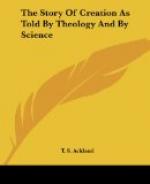This suggestion was eagerly adopted by the members of the French Academy, who were at that time on the look-out for anything which they thought would help them to account for the existence of the world, while they refused to acknowledge a Creator. It was taken up by one of their number—Laplace—a man who stood in the very foremost rank as a mathematician and physical astronomer, and moulded into shape by him.[Footnote: There is a very full account of Laplace’s hypothesis, extracted from the works of Pontecoulant, in Professor Nichol’s System of the World, pp. 69—86.]
He assumed, that the Solar System existed at the very earliest period as a shapeless nebula, a vast undefined mass of “fire-mist;” that at some time or other the separate particles of this fire-mist began to move towards their centre of gravity, under the influence of their mutual attractions, and thus assumed a spherical shape; that by some means or other a motion of rotation was originated in this spherical mass, which increased in rapidity as the process of condensation advanced. The effect of this rotation would be a flattening of the sphere; the equatorial diameter would increase while the polar diameter, or axis of rotation, diminished; and when the centrifugal force thus produced had reached a certain point, a ring would detach itself from the equator, but would continue to revolve about the common centre. He supposed that a succession of rings were thus thrown off, which finally broke up and accumulated into one or more spherical masses, forming the planets and their satellites, while the remainder of the original sphere was condensed into the sun. The planets and their satellites would continue to revolve about the centre as the ring from which they were formed had done, while the different original velocities of the particles of which they were formed, some having been in the outer, some in the inner part of the ring, would cause them also to rotate on their axis. As the condensation advanced, the heat which had originally existed in the “fire-mist” would be condensed also, so that all the masses when formed would be in an incandescent state, but the planets and their satellites being comparatively small would soon cool down, while the sun, owing to its greatly superior bulk, still retains its heat.
There is no doubt much to be said in favour of this theory, which may be more advantageously considered hereafter, when we shall have to consider it as supplementary to the Mosaic account. At present we are only concerned with it as it claims to stand alone, and to be accepted as a substitute for that account. Viewed in this light, as a substitute for a Creator, as showing us how the universe might have come into existence spontaneously, it utterly breaks down in three points.




